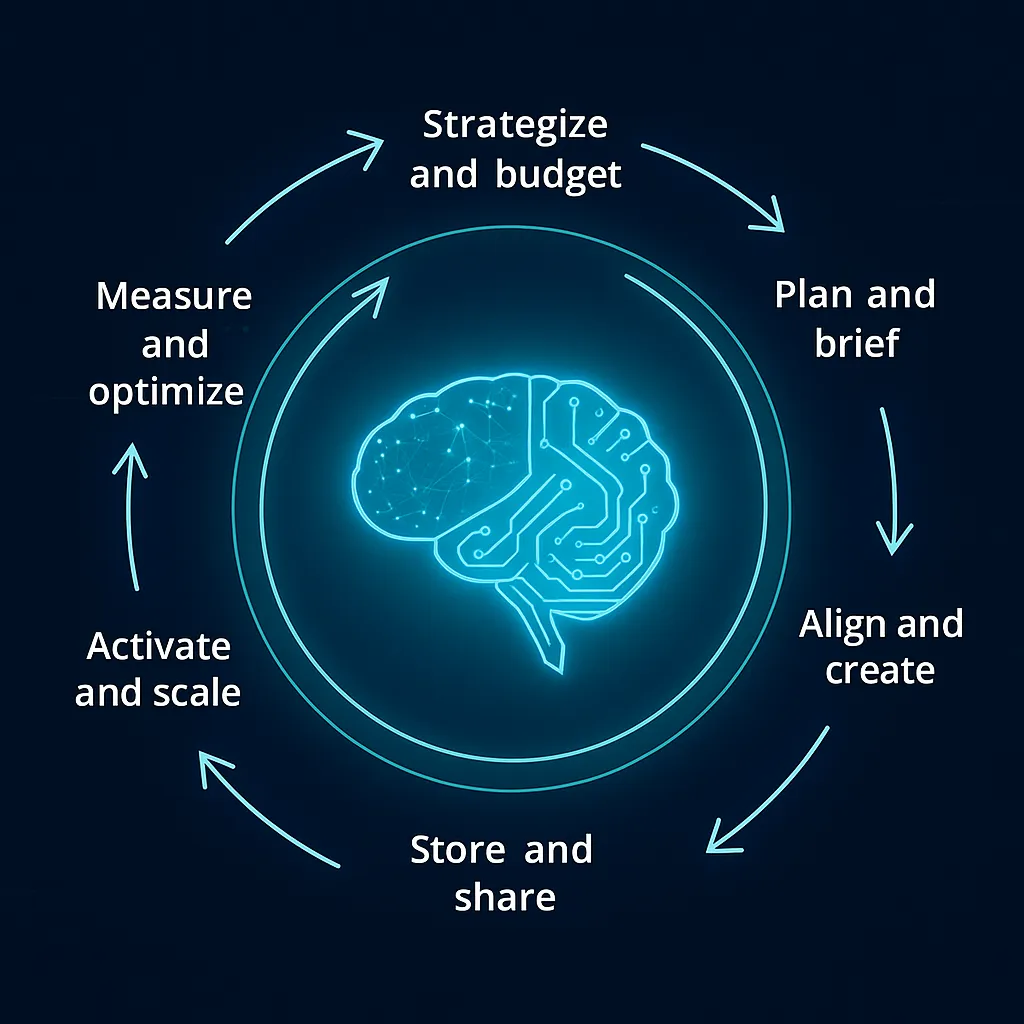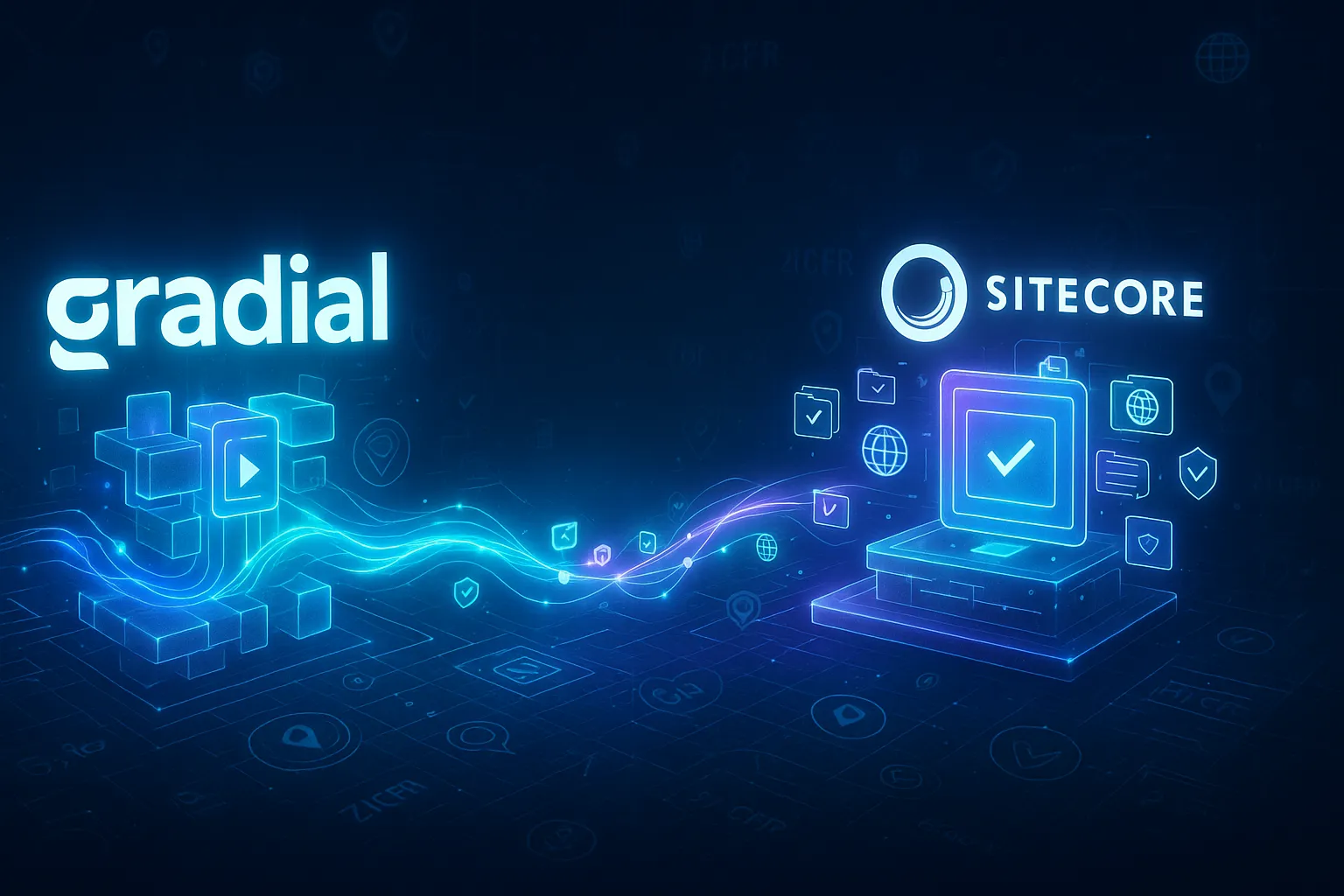The 2026 Content Supply Chain Management Guide
Nov 12, 2025 | 5 min read

How AI, automation, and smarter collaboration are reshaping how content moves from concept to customer.
Executive Summary
By 2026, brands are under immense pressure to deliver personalized, compliant content faster than ever. The solution isn’t just producing more—it’s mastering the content supply chain, the system that governs how every idea becomes an approved, published asset. This guide breaks down how to modernize that system using AI, unified tools, and clear governance to make your marketing engine future-ready.
Understanding the Content Supply Chain (and Why It Matters in 2026)
A content supply chain is the end-to-end process that moves content from concept to customer—from initial idea through planning, creation, review, approval, publishing, and measurement. In plain terms, it’s the system that ensures content flows smoothly from brainstorm to live campaign.
Every company has a version of this chain, whether they’ve formalized it or not. But 2026 demands a sharper, faster, and far more integrated approach. Content needs have exploded: enterprise content volume is projected to reach 155 exabytes by 2026, up from just 47 exabytes in 2021 (Adobe). Nearly 88% of marketers say content demand has at least doubled in the last two years, and 85% feel pressure to deliver faster (Qvest).
Siloed tools and manual steps can’t keep up. Marketers now spend 70% of their time on non-core tasks because of fragmented workflows, draining resources and delaying campaigns. In regulated industries like pharma or finance, where every asset requires legal review, a slow process isn’t just inefficient—it’s risky.
Bottom line: In 2026, speed and compliance are no longer trade-offs. They’re shared requirements. As one expert noted, “If your content process is a mess, AI will just make a bigger mess—faster.”
Plan
Strong content operations start with strong planning. This stage decides what to create, why it matters, and when and where it will appear. A unified plan prevents duplication, conflicting priorities, and chaos later down the line.
How AI helps: Modern planning tools—like Adobe Workfront or similar platforms—use AI to prioritize content requests and forecast workload based on past data. They can analyze historical engagement, predict trending topics, and surface data-driven insights to inform your roadmap.
Teams now use AI assistants like ChatGPT or Claude to brainstorm campaign ideas or generate structured outlines. But the strategy still comes from human marketers—AI simply accelerates the research and organization steps.
Best practice: Maintain a single source of truth. Use a shared content hub or work management platform where all briefs, timelines, and owners are logged. It’s your north star for visibility, helping leaders spot overloads early and keep everyone aligned.
Create
Once you know what you’re producing, the real work begins. Creation today isn’t about producing one perfect asset—it’s about producing many. Marketers must deliver personalized, omnichannel variations without overloading creative teams.
How AI helps: This is AI’s sweet spot. Generative tools can transform the pace of creation. Writers can use AI like ChatGPT or Claude to draft first versions, rewrite, or summarize complex data into clear messaging. Designers use Adobe Firefly or GenStudio to instantly generate brand-consistent images and layouts.
Example: Platforms such as Sitecore Content Hub now integrate AI to power scalable content creation. Marketers can store approved copy blocks—like disclaimers or product blurbs—then use an AI like Gradial to auto-generate new versions or fill templates instantly. Gradial, built for marketing operations, can even draft entire pages and route them for review.
In 2026, AI-assisted creation is the norm, not the novelty. Teams leveraging AI for ideation and iteration report up to 10x faster content output while maintaining human oversight for tone and compliance.
Review
Once drafts are ready, review becomes the next critical step. It’s where you check for clarity, consistency, and compliance—especially vital in industries like healthcare, finance, or life sciences. A single unvetted claim can trigger reputational or legal risk.
How AI helps: AI acts as an intelligent reviewer. Proofreading engines can flag grammar and phrasing issues instantly, but tools like Gradial go further—scanning for unapproved medical claims, missing disclosures, or even privacy red flags.
Gradial’s compliance scoring lets teams focus on what matters most. Instead of reviewing every sentence manually, reviewers see AI-highlighted risk areas, speeding up turnaround without compromising rigor.
And when combined with platforms like Sitecore Content Hub, every edit and approval is logged automatically. AI ensures each mandatory step happens before publication, giving teams a digital safety net. The result: shorter review cycles, fewer errors, and less burnout for compliance teams.
Approve
The approval stage is where ideas become official. Yet for many teams, this is the slowest link in the chain—waiting on legal or executive sign-off can stall campaigns for weeks.
How AI helps: Automation streamlines approvals without bypassing human judgment. AI can generate audit summaries showing what changed, who reviewed it, and whether compliance checks passed. Approvers see, at a glance, that a disclaimer was pre-approved or a claim reused from vetted content.
AI-driven workflow engines like Gradial also handle smart routing—sending items to the right reviewer, sending reminders, and even predicting bottlenecks. If one approver’s queue is full, the system can reroute to an alternate approver, keeping timelines intact.
This combination of context and automation turns approvals from a bottleneck into a fast-moving checkpoint—ensuring compliance stays strong while agility improves.
Publish
Once approved, content moves to distribution. This stage covers everything from publishing blog posts and landing pages to scheduling social posts and email campaigns. But cross-channel coordination remains one of marketers’ biggest pain points.
How AI helps: AI eliminates the repetitive labor of multi-channel publishing. Modern CMS platforms like Sitecore or Adobe Experience Manager can publish content once and push it everywhere automatically—with proper formatting for each channel.
AI enhancements take it further by recommending the best publish time, tagging content automatically, and ensuring brand consistency.
Example: Gradial’s AI agents can bridge tools—pushing approved assets from your content hub into your CMS, applying meta tags and SEO fields, and even triggering localization or Jira tasks automatically (Ciberspring).
That automation lets brands go from approved brief to live experience in hours, not weeks. In 2026, that speed is a competitive advantage—especially when reacting to market shifts or trending topics.
Ready to connect your content systems?
If your content workflow still feels disconnected, it’s time to link strategy, creation, and automation into one seamless loop. Connect with CI Digital to see how our AI-powered integrations and Gradial-enabled frameworks help teams publish faster, reduce compliance risk, and unlock measurable ROI.
Measure
After publishing, measurement closes the loop. It’s where you track engagement, ROI, and improvement opportunities. Without feedback, the supply chain can’t evolve.
How AI helps: Predictive analytics and automated dashboards are transforming this phase. AI tools now pull data from multiple sources—Google Analytics 4, Salesforce Einstein, or social platforms—then surface insights automatically.
Instead of drowning in data, teams see patterns: which posts convert best, which assets get reused, which channels lag behind. Some dashboards even include compliance KPIs alongside marketing metrics—like “% of content reused” or “audit log completion rate.”
According to IBM and Qvest research, companies with a strategically planned, AI-enabled supply chain see up to 22% higher ROI and 30% greater efficiency (Qvest).
By turning measurement into a living feedback system, you can continuously optimize your process and prove that your content engine drives real business results.
Major Challenges and Trends in 2026
Regulatory Pressure: Compliance is now continuous, not periodic. Regulators expect proof that every asset—across every channel—has an audit trail. Privacy laws like GDPR and CCPA require secure handling of personal data, pushing brands to build governance into their workflows from day one.
Cross-Channel Coordination: Consumers interact across websites, apps, email, and social in a single day. Consistency across these touchpoints is now table stakes. Tools like Sitecore Content Hub let brands manage updates centrally so changes propagate everywhere instantly.
Team Collaboration & Remote Work: As hybrid work continues, teams need shared visibility. High-performing organizations use real-time collaboration and version control so planning, creation, and feedback can happen in parallel—not sequentially (Qvest).
Content Reuse & Modularity: “Create once, reuse often” is the 2026 mantra. Modular content libraries—approved text blocks, visuals, disclaimers—ensure consistency and efficiency, especially for regulated sectors.
AI Everywhere (With Governance): The biggest trend is normalization of AI—used in nearly every workflow stage. The priority now is AI governance: review processes, audit logs, and bias detection. As the saying goes, “trust, but verify.”
Recommendations for a Resilient Content Supply Chain
- Map Your Process: Document every step—from planning to publishing—to find bottlenecks and single points of failure.
- Break Down Silos: Use unified systems so marketing, creative, and compliance teams share visibility.
- Embrace Modular Content: Store reusable, approved assets in one searchable repository.
- Automate Repetitive Work: Let AI agents like Gradial handle copy-pasting, tagging, or task routing (Ciberspring).
- Build Compliance In Early: Add automated checkpoints and maintain approval logs to stay audit-ready.
- Train Teams on Tools and AI: Equip people to write better AI prompts and use content hubs effectively.
- Measure and Iterate: Track time-to-publish, reuse rates, and compliance scores to continuously improve.
Conclusion
Content is the engine of modern marketing—and in 2026, that engine must run on efficiency, intelligence, and compliance. A well-managed supply chain transforms content from a scramble into a strategic growth system.
Brands that invest in AI-enabled workflows, modular content, and governance frameworks are already seeing faster turnaround and higher ROI. With tools like Sitecore Content Hub and Gradial, even highly regulated enterprises can move at market speed—securely and confidently.
The technology exists. The strategy is the differentiator.
Ready to modernize your content engine?
Explore our 2026 AI Tools Checklist for Marketers to standardize workflows, and accelerate your supply chain.



 Gradial
Gradial  PEGA
PEGA 





